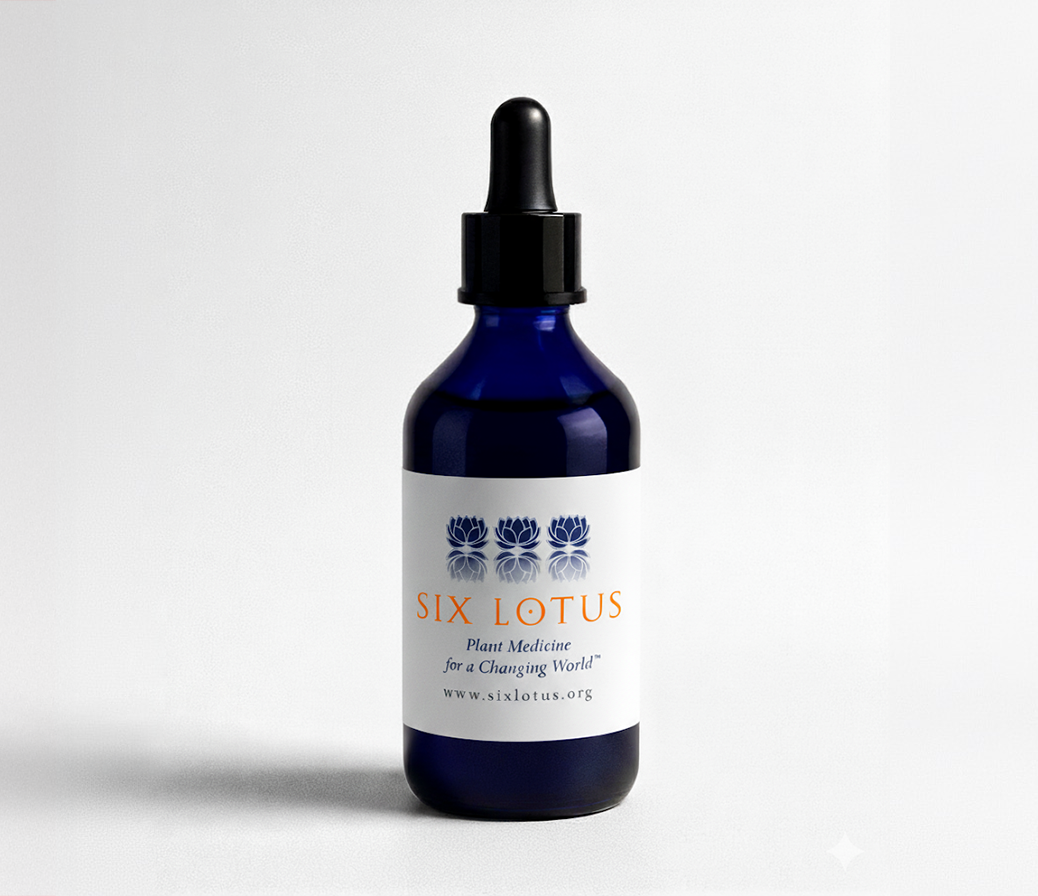Early Parkinson’s
Supports neurological health and antioxidant protection from the earliest stages of change.
A 60mL bottle lasts 1.8 months for an adult. $68 USD.
The Early Parkinson’s Tincture is formulated as both a preventative and therapeutic botanical intervention targeting early-stage Parkinson’s disease. This formulation supports dopaminergic activity, mitochondrial resilience, antioxidant defenses, and neuroinflammatory resolution. Its botanical ingredients also aid microcirculation, cellular detoxification, and adaptogenic buffering of stress — all relevant to the pathophysiology of Parkinsonian syndromes.


Key Botanical Components and Mechanisms
Nymphaea caerulea (blue lotus)
Known for its neuro-calming properties and potential dopaminergic modulation. Traditionally used for its mood-elevating and anxiolytic effects.
Cinchona spp. (chinchona tree bark)
Contains quinine derivatives that support cerebral microcirculation and systemic anti-inflammatory effects. Enhances oxygenation to midbrain tissues.
Sesamum indicum (white sesame seeds)
Rich in sesamin, a lignan with antioxidant and anti-inflammatory activity. Supports neuronal membrane integrity and inhibits MAO-B enzyme activity, relevant to dopamine preservation.
Palmaria palmata (dulse flakes)
Marine source of iodine, potassium, and magnesium. Supports thyroid health and neuromuscular balance. Contains polysaccharides that may buffer neurotoxic stress.
Rhodiola rosea (rhodiola root)
Adaptogen that improves resilience to physiological stress, regulates cortisol, and promotes mitochondrial function. May reduce fatigue and depression associated with early Parkinson’s.
Astragalus membranaceus (astragalus root)
Immunomodulator with anti-aging and mitochondrial-supportive activity. May protect neurons through its antioxidant effects and enhancement of telomerase activity.
Citrus x meyeri (lemon) & Citrus x latifolia (lime)
Natural sources of vitamin C and flavonoids. Support liver detoxification and antioxidant recycling. Assist in preserving dopamine levels through reduction of oxidative burden.
Arctium lappa (burdock root) OR Inonotus obliquus (chaga mushroom)
Burdock root: Supports liver and blood detoxification. Its inulin content nourishes gut flora, enhancing the gut-brain axis. Anti-inflammatory and antioxidant compounds reduce systemic burden that may contribute to neurodegeneration.
Chaga mushroom: Rich in betulinic acid, melanin, and polysaccharides. Strong antioxidant capacity protects against free radical damage in dopaminergic neurons. May support mitochondrial respiration and immune modulation.
Solvent System
Non-GMO French Vodka: This 80-proof ethanol extract preserves a broad spectrum of hydrophilic and lipophilic phytochemicals critical for neurological, mitochondrial, and vascular support.
Summary
The Early Parkinson’s Tincture combines botanicals that support dopaminergic function, reduce oxidative and inflammatory triggers, and bolster stress adaptation mechanisms. Its integrative design allows for both preventative use in at-risk individuals and therapeutic use in early diagnosed cases. The formula enhances cellular resilience, neurotransmitter conservation, and neuromuscular harmony.
What You Can Do To Support Your Body
Early Neuro Support
Goal: Support oxidative balance, energy metabolism, and motor function.
Diet:
Fruits: Blueberries, grapes, blackberries
Vegetables: Spinach, kale, carrots, beets
Herbs/Spices: Turmeric, rosemary, thyme
Fungi: Lion’s mane, shiitake
Minerals: Magnesium (pumpkin seeds, beans), zinc (sesame, chickpeas)
Beverages: Green tea, rosemary tea
Lifestyle: Aerobic activity, balance and strength training, hydration, and fiber-rich foods for bowel health.
Why diet matters: Nutrient-dense plant foods and herbs help support nerve health and motor performance, working with the tincture’s brain-supportive profile.
These statements have not been evaluated by the Food and Drug Administration. This product is not intended to diagnose, treat, cure, or prevent any disease.
References
Bone, K. and Mills, S., 2013. Principles and Practice of Phytotherapy. 2nd ed. Churchill Livingstone.
Chevallier, A., 2016. Encyclopedia of Herbal Medicine. DK Publishing.
Liu, X., Zhang, M., Zhang, R. and Deng, Y., 2012. ‘Chaga mushroom extract exhibits neuroprotective effects in models of neurodegeneration’, Journal of Ethnopharmacology, 140(2), pp.275–284.
Panossian, A. and Wikman, G., 2008. ‘Pharmacology of Rhodiola rosea: A review’, Phytomedicine, 15(1–2), pp.83–91.
Tamtaji, O.R., Taghizadeh, M., Daneshvar, K. and Asemi, Z., 2019. ‘The role of oxidative stress in Parkinson’s disease and the protective effect of natural antioxidants’, Biomedicine & Pharmacotherapy, 111, pp.228–236.
Wang, Y., Yu, H., Zhang, L., Wang, T. and Wang, J., 2017. ‘Astragalus and its constituents protect against neuronal oxidative stress and mitochondrial dysfunction’, Neurochemistry International, 108, pp.287–294.



